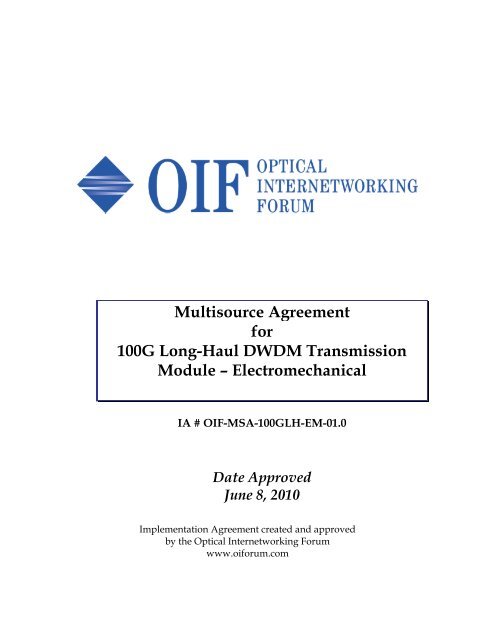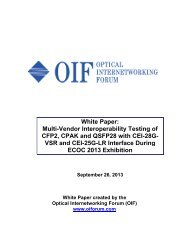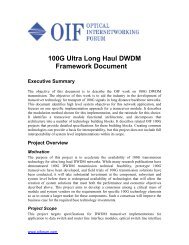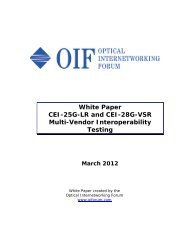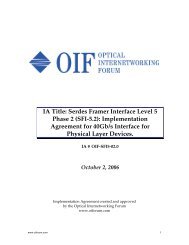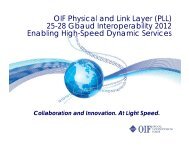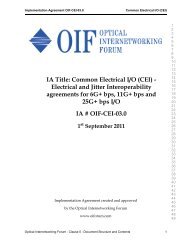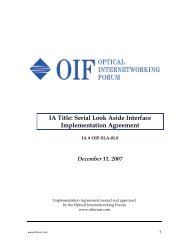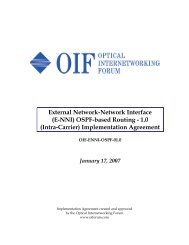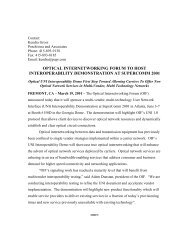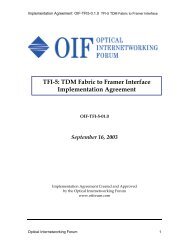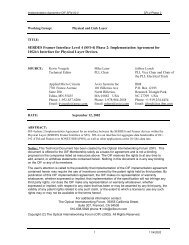Multisource Agreement for 100G Long-Haul DWDM Transmission Module ...
Multisource Agreement for 100G Long-Haul DWDM Transmission Module ...
Multisource Agreement for 100G Long-Haul DWDM Transmission Module ...
Create successful ePaper yourself
Turn your PDF publications into a flip-book with our unique Google optimized e-Paper software.
<strong>Multisource</strong> <strong>Agreement</strong><br />
<strong>for</strong><br />
<strong>100G</strong> <strong>Long</strong>-<strong>Haul</strong> <strong>DWDM</strong> <strong>Transmission</strong><br />
<strong>Module</strong> – Electromechanical<br />
IA # OIF-MSA-<strong>100G</strong>LH-EM-01.0<br />
Date Approved<br />
June 8, 2010<br />
Implementation <strong>Agreement</strong> created and approved<br />
by the Optical Internetworking Forum<br />
www.oi<strong>for</strong>um.com
OIF-MSA-<strong>100G</strong>LH-EM-01.0<br />
WORKING GROUP: Physical and Link Layer (PLL) Working Group<br />
TITLE: <strong>Multisource</strong> <strong>Agreement</strong> <strong>for</strong> <strong>100G</strong> <strong>Long</strong>-<strong>Haul</strong> <strong>DWDM</strong> <strong>Transmission</strong> <strong>Module</strong> –<br />
Electromechanical<br />
SOURCE: TECHNICAL EDITOR WORKING GROUP CHAIR<br />
Jon Anderson, Ph. D. David R. Stauffer, Ph. D.<br />
Opnext, Inc.<br />
IBM Corporation<br />
46429 Landing Parkway 1000 River Road, MC 862J<br />
Fremont, CA 94538 Essex Jct., VT 05452<br />
Phone: +1-510-580-8832 Phone: +1-802-769-6914<br />
Email: janderson@opnext.com Email: dstauffe@us.ibm.com<br />
WORKING GROUP VICE CHAIR<br />
Karl Gass<br />
Sandia National Laboratories<br />
P. O. Box 5800 MS-0874<br />
Phone: +1-505-844-8849<br />
Email: kgass@sandia.gov<br />
ABSTRACT: This <strong>Multisource</strong> <strong>Agreement</strong> specifies key electromechanical aspects of a <strong>100G</strong><br />
<strong>Long</strong>-<strong>Haul</strong> <strong>DWDM</strong> <strong>Transmission</strong> <strong>Module</strong>, <strong>for</strong> applications such as <strong>100G</strong> PM-QPSK long-haul<br />
<strong>DWDM</strong> transmission. Key aspects include: module mechanical dimensions, electrical connector<br />
and pin assignment, module hardware signaling pins, high-speed electrical characteristics, power<br />
supply, power dissipation, and management interface.<br />
www.oi<strong>for</strong>um.com 2
OIF-MSA-<strong>100G</strong>LH-EM-01.0<br />
The OIF is an international non profit organization with over 90 member companies,<br />
including the world’s leading carriers and vendors. Being an industry group uniting<br />
representatives of the data and optical worlds, OIF’s purpose is to accelerate the deployment<br />
of interoperable, cost-effective and robust optical internetworks and their associated<br />
technologies. Optical internetworks are data networks composed of routers and data switches<br />
interconnected by optical networking elements.<br />
With the goal of promoting worldwide compatibility of optical internetworking products, the<br />
OIF actively supports and extends the work of national and international standards bodies.<br />
Working relationships or <strong>for</strong>mal liaisons have been established with IEEE 802.1, IEEE 802.3ba,<br />
IETF, IP-MPLS Forum, IPv6 Forum, ITU-T SG13, ITU-T SG15, MEF, ATIS-OPTXS, ATIS-<br />
TMOC, TMF and the XFP MSA Group.<br />
For additional in<strong>for</strong>mation contact:<br />
The Optical Internetworking Forum, 48377 Fremont Blvd.,<br />
Suite 117, Fremont, CA 94538<br />
510-492-4040 Φ info@oi<strong>for</strong>um.com<br />
www.oi<strong>for</strong>um.com<br />
Notice: This Technical Document has been created by the Optical Internetworking Forum (OIF). This document is<br />
offered to the OIF Membership solely as a basis <strong>for</strong> agreement and is not a binding proposal on the companies listed as<br />
resources above. The OIF reserves the rights to at any time to add, amend, or withdraw statements contained herein.<br />
Nothing in this document is in any way binding on the OIF or any of its members.<br />
The user's attention is called to the possibility that implementation of the OIF implementation agreement contained herein<br />
may require the use of inventions covered by the patent rights held by third parties. By publication of this OIF<br />
implementation agreement, the OIF makes no representation or warranty whatsoever, whether expressed or implied, that<br />
implementation of the specification will not infringe any third party rights, nor does the OIF make any representation or<br />
warranty whatsoever, whether expressed or implied, with respect to any claim that has been or may be asserted by any<br />
third party, the validity of any patent rights related to any such claim, or the extent to which a license to use any such<br />
rights may or may not be available or the terms hereof.<br />
© 2010 Optical Internetworking Forum<br />
This document and translations of it may be copied and furnished to others, and derivative works that comment on or<br />
otherwise explain it or assist in its implementation may be prepared, copied, published and distributed, in whole or in<br />
part, without restriction other than the following, (1) the above copyright notice and this paragraph must be included on<br />
all such copies and derivative works, and (2) this document itself may not be modified in any way, such as by removing<br />
the copyright notice or references to the OIF, except as needed <strong>for</strong> the purpose of developing OIF Implementation<br />
<strong>Agreement</strong>s.<br />
By downloading, copying, or using this document in any manner, the user consents to the terms and conditions of this<br />
notice. Unless the terms and conditions of this notice are breached by the user, the limited permissions granted above are<br />
perpetual and will not be revoked by the OIF or its successors or assigns.<br />
This document and the in<strong>for</strong>mation contained herein is provided on an “AS IS” basis and THE OIF DISCLAIMS ALL<br />
WARRANTIES, EXPRESS OR IMPLIED, INCLUDING BUT NOT LIMITED TO ANY WARRANTY THAT THE USE OF<br />
THE INFORMATION HEREIN WILL NOT INFRINGE ANY RIGHTS OR ANY IMPLIED WARRANTIES OF<br />
MERCHANTABILITY, TITLE OR FITNESS FOR A PARTICULAR PURPOSE.<br />
www.oi<strong>for</strong>um.com 3
OIF-MSA-<strong>100G</strong>LH-EM-01.0<br />
1 Table of Contents<br />
1 Table of Contents......................................................................................4<br />
2 List of Figures............................................................................................5<br />
3 List of Tables.............................................................................................6<br />
4 Document Revision History .....................................................................7<br />
5 Introduction ..............................................................................................8<br />
6 Functional Description .............................................................................8<br />
7 <strong>Module</strong> Management Interface Description ............................................9<br />
8 Electrical Specifications ............................................................................9<br />
8.1 Operating Case Temperature.............................................................9<br />
8.2 Electrical Power Supply and Power Dissipation...............................9<br />
8.3 High Speed Pin Electrical Specifications ........................................10<br />
8.4 Control Pins (non-MDIO) Functional Description .........................12<br />
8.5 Alarm Pins (non-MDIO) Functional Description ...........................15<br />
8.6 <strong>Module</strong> Management Interface Pins (MDIO) Description.............18<br />
8.7 Hardware Signaling Pin Electrical Specifications ..........................20<br />
8.8 Hardware Signaling Pin Timing Specifications .............................22<br />
9 Mechanical Specifications ......................................................................24<br />
9.1 Mechanical Overview ......................................................................24<br />
9.2 Electrical Connector .........................................................................24<br />
9.3 <strong>Module</strong> Dimensions ........................................................................27<br />
9.4 Host System Dimensions.................................................................32<br />
9.5 <strong>Module</strong> Optical Fiber Ports .............................................................33<br />
9.6 Pin Assignment................................................................................33<br />
10 References............................................................................................37<br />
10.1 Normative references.......................................................................37<br />
10.2 In<strong>for</strong>mative references.....................................................................37<br />
11 Appendix A: Glossary .........................................................................38<br />
12 Appendix B: Open Issues / current work items ..................................39<br />
13 Appendix C: List of companies belonging to OIF when document was<br />
approved.........................................................................................................40<br />
14 Appendix D (in<strong>for</strong>mative): Pin Map Allocation <strong>for</strong> 40G Applications<br />
41<br />
www.oi<strong>for</strong>um.com 4
OIF-MSA-<strong>100G</strong>LH-EM-01.0<br />
2 List of Figures<br />
FIGURE 1: <strong>100G</strong> LONG-HAUL <strong>DWDM</strong> TRANSMISSION MODULE (MSA-<strong>100G</strong>LH)<br />
FUNCTIONAL DIAGRAM ............................................................................................. 9<br />
FIGURE 2: HIGH SPEED I/O FOR DATA AND CLOCKS..................................................... 11<br />
FIGURE 3: TRANSMITTER DISABLE (TX_DIS) TIMING DIAGRAM.................................... 14<br />
FIGURE 4: MODULE LOW POWER (MOD_LOPWR) TIMING DIAGRAM........................ 15<br />
FIGURE 5: RECEIVER LOSS OF SIGNAL (RX_LOS) TIMING DIAGRAM............................. 17<br />
FIGURE 6: GLOBAL ALARM (GLB_ALRMN) TIMING DIAGRAM.................................... 18<br />
FIGURE 7: MODULE MDIO & MDC TIMING DIAGRAM ................................................. 20<br />
FIGURE 8: REFERENCE +3.3V LVCMOS INPUT/OUTPUT TERMINATIONS.................... 21<br />
FIGURE 9: REFERENCE MDIO INTERFACE TERMINATION............................................... 22<br />
FIGURE 10: MSA-<strong>100G</strong>LH SIMPLIFIED START-UP FLOW DIAGRAM.............................. 23<br />
FIGURE 11: HIROSE FX10A-168S-SV(83) RECEPTACLE CONNECTOR ASSEMBLY.......... 25<br />
FIGURE 12: HIROSE FX10A-168P-SV(83) HEADER CONNECTOR ASSEMBLY ................ 26<br />
FIGURE 13: FX10 CONNECTOR ALIGNMENT ................................................................... 27<br />
FIGURE 14: MSA-<strong>100G</strong>LH NON-CONDUCTIVE SHEET DIMENSIONS.................................. 28<br />
FIGURE 15: MSA-<strong>100G</strong>LH FLATTOP MECHANICAL DIMENSIONS - BOTTOM/SIDE VIEWS<br />
................................................................................................................................... 29<br />
FIGURE 16: MSA-<strong>100G</strong>LH FLATTOP MECHANICAL DIMENSIONS - TOP VIEW................ 30<br />
FIGURE 17: MECHANICAL DIMENSIONS OF MSA-<strong>100G</strong>LH WITH INTEGRATED HEAT<br />
SINK .......................................................................................................................... 31<br />
FIGURE 18: MSA-<strong>100G</strong>LH WITH INTEGRATED HEAT SINK - TOP VIEW ......................... 32<br />
FIGURE 19: RECOMMENDED HOST SYSTEM LAYOUT FOR MSA-<strong>100G</strong>LH ..................... 32<br />
FIGURE 20: MSA-<strong>100G</strong>LH OPTICAL FIBER PORT LOCATION AND DIMENSIONS .......... 33<br />
www.oi<strong>for</strong>um.com 5
OIF-MSA-<strong>100G</strong>LH-EM-01.0<br />
3 List of Tables<br />
TABLE 1: MSA-<strong>100G</strong>LH PERFORMANCE SPECIFICATIONS............................................. 10<br />
TABLE 2: MSA-<strong>100G</strong>LH REFERENCE CLOCK (REFCLK) CHARACTERISTICS ............... 11<br />
TABLE 3: OPTIONAL TXMCLK AND RXMCLK CHARACTERISTICS .............................. 12<br />
TABLE 4: MSA-<strong>100G</strong>LH CONTROL PINS (NON-MDIO) ................................................ 13<br />
TABLE 5: MSA-<strong>100G</strong>LH ALARM PINS (NON-MDIO) .................................................... 16<br />
TABLE 6: MSA-<strong>100G</strong>LH MDIO MANAGEMENT INTERFACE PINS ................................ 19<br />
TABLE 7: 3.3V LVCMOS ELECTRICAL CHARACTERISTICS ............................................. 20<br />
TABLE 8: 1.2V LVCMOS ELECTRICAL CHARACTERISTICS ............................................. 21<br />
TABLE 9: HARDWARE SIGNALING PINS TIMING PARAMETERS SUMMARY..................... 23<br />
TABLE 10: MSA-<strong>100G</strong>LH PIN-MAP................................................................................ 34<br />
TABLE 11: MSA-<strong>100G</strong>LH ELECTRICAL CONNECTOR - ROW B PIN DESCRIPTION ........ 35<br />
TABLE 12: MSA-<strong>100G</strong>LH ELECTRICAL CONNECTOR - ROW A PIN DESCRIPTION........ 36<br />
TABLE 13: MSA-<strong>100G</strong>LH ELECTRICAL CONNECTOR - ROW B PIN MAP (40G<br />
APPLICATION) .......................................................................................................... 42<br />
TABLE 14: MSA-<strong>100G</strong>LH ELECTRICAL CONNECTOR - ROW A PIN MAP (40G<br />
APPLICATION) .......................................................................................................... 43<br />
www.oi<strong>for</strong>um.com 6
OIF-MSA-<strong>100G</strong>LH-EM-01.0<br />
4 Document Revision History<br />
WORKING GROUP: Physical and Link Layer (PLL) Working Group<br />
SOURCE: TECHNICAL EDITOR WORKING GROUP CHAIR<br />
Jon Anderson, Ph. D. David R. Stauffer, Ph. D.<br />
Opnext, Inc.<br />
IBM Corporation<br />
46429 Landing Parkway 1000 River Road, MC 862J<br />
Fremont, CA 94538 Essex Jct., VT 05452<br />
Phone: +1-510-580-8832 Phone: +1-802-769-6914<br />
Email: janderson@opnext.com Email: dstauffe@us.ibm.com<br />
WORKING GROUP VICE CHAIR<br />
Karl Gass<br />
Sandia National Laboratories<br />
P. O. Box 5800 MS-0874<br />
Phone: +1-505-844-8849<br />
Email: kgass@sandia.gov<br />
DATE: June 8, 2010<br />
Version 1.0 created from oif2009.388.02 on June 8, 2010.<br />
www.oi<strong>for</strong>um.com 7
OIF-MSA-<strong>100G</strong>LH-EM-01.0<br />
5 Introduction<br />
This document details a <strong>Multisource</strong> <strong>Agreement</strong> (IA) <strong>for</strong> a <strong>100G</strong> <strong>Long</strong>-<strong>Haul</strong> <strong>DWDM</strong><br />
<strong>Transmission</strong> <strong>Module</strong> – Electromechanical (MSA-<strong>100G</strong>LH) <strong>for</strong> optical line interface<br />
applications. While specifically addressing <strong>100G</strong> PM-QPSK long-haul <strong>DWDM</strong><br />
transmission applications [I1], this MSA strives to remain modulation <strong>for</strong>mat and data<br />
rate agnostic whenever practical to maximize applicability to future market<br />
requirements.<br />
This MSA specifies key electromechanical aspects of the <strong>100G</strong> <strong>Long</strong>-<strong>Haul</strong> <strong>DWDM</strong><br />
<strong>Transmission</strong> <strong>Module</strong> (hereafter termed MSA-<strong>100G</strong>LH) that include the following:<br />
module mechanical dimensions, electrical connector and pin map, module hardware<br />
signaling pins, high-speed electrical characteristics, power supply, power dissipation,<br />
and management interface.<br />
6 Functional Description<br />
A functional block diagram of the MSA-<strong>100G</strong>LH is illustrated in Figure 1. Key module<br />
functions include transmitter optics, receiver optics, interface ICs, module controller<br />
supporting an MDIO/MDC management interface, and power conversion <strong>for</strong> a single<br />
+12V DC power supply from the host. The MSA-<strong>100G</strong>LH is not hot pluggable, but is<br />
fastened to the host system board during line card assembly. The interface IC(s) and<br />
module electrical interface are generically specified to allow vendor specific<br />
customization of multilane “M-lane” ~ 11 Gbit/s interfaces. <strong>Module</strong> electrical interfaces<br />
include but are not limited to the following:<br />
a) Simple bit multiplex<br />
b) OTL4.10 [I2]<br />
c) SFI-S [I3]<br />
d) OTL3.4 [I2] (<strong>for</strong> 40G applications, see in<strong>for</strong>mative Appendix D)<br />
www.oi<strong>for</strong>um.com 8
OIF-MSA-<strong>100G</strong>LH-EM-01.0<br />
Figure 1: <strong>100G</strong> <strong>Long</strong>-<strong>Haul</strong> <strong>DWDM</strong> <strong>Transmission</strong> <strong>Module</strong> (MSA-<strong>100G</strong>LH) Functional<br />
Diagram<br />
7 <strong>Module</strong> Management Interface Description<br />
The MSA-<strong>100G</strong>LH utilizes MDIO IEEE 802.3 Clause 45 [N1] <strong>for</strong> its management<br />
interface. The MSA-<strong>100G</strong>LH MDIO hardware implementation is specified in Section 8.6.<br />
The MSA-<strong>100G</strong>LH MDIO register set specifications will be defined in a future document<br />
entitled “Implementation <strong>Agreement</strong> <strong>for</strong> a MDIO Management Interface to the <strong>100G</strong><br />
<strong>Long</strong>-<strong>Haul</strong> <strong>DWDM</strong> <strong>Transmission</strong> <strong>Module</strong>”. When multiple MSA-<strong>100G</strong>LH are connected<br />
via a single bus, a particular MSA-<strong>100G</strong>LH may be selected by using the MDIO Physical<br />
Port Address pins.<br />
8 Electrical Specifications<br />
8.1 Operating Case Temperature<br />
The MSA-<strong>100G</strong>LH operating case temperature is specified in Table 1.<br />
8.2 Electrical Power Supply and Power Dissipation<br />
The MSA-<strong>100G</strong>LH is powered by a single +12V DC supply from the host board. This<br />
power supply is specified in Table 1. All voltages are measured at the electrical<br />
connector interface.<br />
The MSA-<strong>100G</strong>LH power dissipation is specified in Table 1.<br />
www.oi<strong>for</strong>um.com 9
OIF-MSA-<strong>100G</strong>LH-EM-01.0<br />
Table 1: MSA-<strong>100G</strong>LH Per<strong>for</strong>mance Specifications<br />
Parameter Symbol Min Typ Max Unit Note<br />
+12V DC Supply Voltage V CC 11.4 12.0 12.6 V +/- 5%<br />
+12V DC Supply Current I CC 8.0 A Notes 1 & 2<br />
Power Supply Noise V rip 1 %p-p 1Hz – 20MHz<br />
Power Dissipation P w 80 W<br />
Operating Case Temperature 0 70 °C<br />
Note: The parameter min and max values are specified End-of-Life within the overall relevant<br />
operating case temperature range. The typical values are referenced to +25°C, nominal power<br />
supply, Beginning-of -Life.<br />
Note 1: Maximum current per pin shall not exceed 750mA.<br />
Note 2: Icc max specified <strong>for</strong> current rating purposes. Normal operating current (Icc) must not<br />
exceed Pw / Vcc.<br />
8.3 High Speed Pin Electrical Specifications<br />
8.3.1 Transmitter Data (TX)<br />
The Transmitter Data (TX) signals shall comply with CEI-11G-MR Low Swing option as<br />
per Clauses 9.3.1. and 9.3.1.2 [N2]. Full Swing support is not required. The<br />
recommended termination of the TX pins is given in Figure 2.<br />
8.3.2 Receiver Data (RX)<br />
The Receiver Data (RX) signals shall comply with CEI-11G-MR Clause 9.3.3 [N2]. The<br />
recommended termination of the RX pins is given in Figure 2.<br />
8.3.3 Reference Clock (REFCLK)<br />
The host shall supply a reference clock (REFCLK) at 1/16 of the electrical lane rate. The<br />
host shall optionally supply a reference clock (REFCLK) at 1/64 of the electrical lane<br />
rate.<br />
The REFCLK shall be CML differential AC coupled and terminated with 50 Ohm<br />
internal V TT within the MSA-<strong>100G</strong>LH, as shown in Figure 2. A frequency locked<br />
relationship is required between the transmit data lanes (TX/TXDSC) and the reference<br />
clock (REFCLK). There is no required phase relationship between the data lanes and the<br />
reference clock. The REFCLK frequency shall not deviate from nominal by more than<br />
±20 ppm. Detailed reference clock characteristics <strong>for</strong> the MSA-<strong>100G</strong>LH are given in<br />
Table 2.<br />
www.oi<strong>for</strong>um.com 10
OIF-MSA-<strong>100G</strong>LH-EM-01.0<br />
Table 2: MSA-<strong>100G</strong>LH Reference Clock (REFCLK) Characteristics<br />
Parameter Symbol Min Typ Max Unit Notes<br />
Impedance Z d 80 100 120 Ω<br />
Frequency<br />
f<br />
1/16 Of electrical lane rate -<br />
default<br />
1/64 Of electrical lane rate -<br />
optional<br />
Frequency<br />
Δf -20 +20 ppm<br />
Stability<br />
Differential V DIFF 400 1600 mV Peak-to-Peak Differential<br />
Voltage<br />
Clock Duty Cycle CDC 40 60 %<br />
Clock Rise/Fall t r/f 200 1250 ps 1/64 electrical lane rate<br />
Time<br />
50 315 ps 1/16 electrical lane rate<br />
Figure 2: High Speed I/O <strong>for</strong> Data and Clocks<br />
8.3.4 Transmitter Monitor Clock (TXMCLK)<br />
The MSA-<strong>100G</strong>LH optionally may supply a transmitter monitor clock (TXMCLK). This<br />
clock is intended to be used as a reference <strong>for</strong> measurements of the module optical<br />
transmit signal. If provided, the clock shall operate at 1/8 of the transmitter optical<br />
www.oi<strong>for</strong>um.com 11
OIF-MSA-<strong>100G</strong>LH-EM-01.0<br />
symbol rate <strong>for</strong> 32Gb applications 1 . This rate is optimized <strong>for</strong> triggering high-speed<br />
sampling scopes. Clock termination is shown in Figure 2. TXMCLK characteristics are<br />
summarized in Table 3.<br />
8.3.5 Receiver Monitor Clock (RXMCLK)<br />
The MSA-<strong>100G</strong>LH optionally may supply a receiver monitor clock (RXMCLK). This<br />
clock is intended to be used as a reference <strong>for</strong> measurements of the module receive data.<br />
If provided, the clock shall operate at 1/16 of the receiver electrical lane data rate. The<br />
RXMCLK may optionally operate at 1/64 of the receiver electrical lane data rate. Clock<br />
termination is shown in Figure 2. RXMCLK characteristics are summarized in Table 3.<br />
Table 3: Optional TXMCLK and RXMCLK Characteristics<br />
Parameter Symbol Min Typ Max Unit Notes<br />
Impedance Z d 80 100 120 Ω<br />
Frequency -<br />
TXMCLK<br />
1/8 Of TX optical symbol rate<br />
- default<br />
Frequency -<br />
RXMCLK<br />
1/16<br />
1/64<br />
Of RX electrical lane data<br />
rate - default<br />
Of RX electrical lane data<br />
rate - optional<br />
Output<br />
V DIFF 400 1600 mV Peak-to-Peak Differential<br />
Differential<br />
Voltage<br />
Clock Duty Cycle CDC 40 60 %<br />
8.4 Control Pins (non-MDIO) Functional Description<br />
The control functions between a host and a MSA-<strong>100G</strong>LH are conducted through a set of<br />
dedicated, non-data hardware signal pins on the 168-pin electrical connector and via an<br />
MDIO interface. The signal pins work together with the MDIO interface to <strong>for</strong>m a<br />
complete HOST/MSA-<strong>100G</strong>LH management interface. Upon module initialization, the<br />
control functions are available. Pins allocated to control functions in the 168-pin<br />
electrical connector are listed in Table 4.<br />
1 For 40G applications, other clock rates may be necessary <strong>for</strong> operating with available test<br />
equipment.<br />
www.oi<strong>for</strong>um.com 12
OIF-MSA-<strong>100G</strong>LH-EM-01.0<br />
Pin<br />
#<br />
Table 4: MSA-<strong>100G</strong>LH Control Pins (non-MDIO)<br />
Symbol Description I<br />
/<br />
O<br />
B20 PRG_CNTL1 Programmable Control 1<br />
Default: TRXIC_RSTn, TX & RX<br />
ICs reset,<br />
“0”: reset, “1” or NC: enabled<br />
B19 PRG_CNTL2 Programmable Control 2<br />
For Future Use<br />
B18 PRG_CNTL3 Programmable Control 3<br />
For Future Use<br />
B13 PM_SYNC Per<strong>for</strong>mance Monitoring Sync<br />
Rising edge synchronizes PM<br />
statistics counters<br />
B11 TX_DIS Transmitter Disable<br />
“0”: transmitter enabled<br />
“1” or NC: transmitter disabled<br />
B10 MOD_LOPWR <strong>Module</strong> Low Power<br />
“0”: power-on enabled<br />
“1” or NC: module in low power<br />
(safe) mode<br />
B9 MOD_ RSTn <strong>Module</strong> Reset<br />
“0”: resets the module<br />
“1”: module enabled<br />
Logic “H” “L” Pull-up<br />
/down<br />
I 3.3V Per MDIO<br />
LVCMOS document<br />
Pull–Up 1<br />
I 3.3V<br />
LVCMOS<br />
I 3.3V<br />
LVCMOS<br />
I 3.3V<br />
LVCMOS<br />
I 3.3V<br />
LVCMOS<br />
I 3.3V<br />
LVCMOS<br />
I 3.3V<br />
LVCMOS<br />
Pull–Up 1<br />
Pull–Up 1<br />
Pull-Down 2<br />
Disable Enable Pull-Up 1<br />
Low<br />
Power<br />
Note 1: Pull-Up resistor (4.7k - 10kOhm) is located within the MSA-<strong>100G</strong>LH.<br />
Note 2: Pull-Down resistor (4.7k - 10kOhm) is located within the MSA-<strong>100G</strong>LH.<br />
Enable Pull–Up 1<br />
Enable Reset Pull-Down 2<br />
8.4.1 Programmable Control Pins (PRG_CNTLs)<br />
The Programmable Control pins (PRG_CNTL) allow the host to program certain MSA-<br />
<strong>100G</strong>LH control functions via a hardware pin. The intention is to allow <strong>for</strong> maximum<br />
design and debug flexibility. The default setting <strong>for</strong> Control 1 is control of the Transmit<br />
& Receive Reset. Controls 2 and 3 are <strong>for</strong> future use.<br />
8.4.1.1 Programmable Control 1 Pin (PRG_CNTL1)<br />
Programmable Control 1 Pin (PRG_CNTL1) is an input pin from the host, operating<br />
with programmable logic. It is pulled up in the MSA-<strong>100G</strong>LH. It can be re-programmed<br />
over MDIO registers to another MDIO control register while the module is in any steady<br />
state except Reset. The default function is Transmit & Receive circuitry reset<br />
(TRXIC_RSTn) with active-low logic. When TRXIC_RSTn is asserted (driven low), the<br />
digital transmit and receive circuitry is reset clearing all FIFOs and/or resetting all<br />
CDRs. When de-asserted, the digital transmit and receive circuitry shall resume normal<br />
operation.<br />
8.4.1.2 Programmable Control 2 Pin (PRG_CNTL2)<br />
Programmable Control 2 Pin (PRG_CNTL2) is an input from the host, operating with<br />
programmable logic. It is pulled up in the MSA-<strong>100G</strong>LH. It can be re-programmed over<br />
www.oi<strong>for</strong>um.com 13
OIF-MSA-<strong>100G</strong>LH-EM-01.0<br />
MDIO registers to another MDIO control register while the module is in any steady state<br />
except Reset. It is reserved <strong>for</strong> future use.<br />
8.4.1.3 Programmable Control 3 Pin (PRG_CNTL3)<br />
Programmable Control 3 Pin (PRG_CNTL3) is an input from the host, operating with<br />
programmable logic. It is pulled up in the MSA-<strong>100G</strong>LH. It can be re-programmed over<br />
MDIO registers to another MDIO control register while the module is in any steady state<br />
except Reset. It is reserved <strong>for</strong> future use.<br />
8.4.1.4 Per<strong>for</strong>mance Monitoring Synchronization (PM_SYNC)<br />
The Per<strong>for</strong>mance Monitoring Synchronization pin (PM_SYNC) is an input from the host.<br />
The purpose of this pin is to provide a synchronization pulse from the host time<br />
reference source <strong>for</strong> synchronizing module-level per<strong>for</strong>mance monitoring data collection<br />
with host system per<strong>for</strong>mance monitoring data collection. The default time period of<br />
this signal is 1 second. Use of PM_SYNC is optional <strong>for</strong> the MSA-<strong>100G</strong>LH.<br />
8.4.1.5 Transmitter Disable Pin (TX_DIS)<br />
The Transmitter Disable pin (TX_DIS) is an input from the host, operating with activehigh<br />
logic. This pin is pulled up in the MSA-<strong>100G</strong>LH. When TX_DIS is asserted, all of<br />
the optical outputs inside a MSA-<strong>100G</strong>LH shall be switched off. When this pin is deasserted,<br />
optical transmitters shall be switched on according to a predefined TX poweron<br />
process defined by module vendor specification. The timing diagram <strong>for</strong> TX_DIS pin<br />
is illustrated in Figure 3. Values <strong>for</strong> t_off and t_on are application specific and not<br />
specified in this IA.<br />
Figure 3: Transmitter Disable (TX_DIS) Timing Diagram<br />
8.4.1.6 <strong>Module</strong> Low Power Pin (MOD_LOPWR)<br />
The <strong>Module</strong> Low Power pin (MOD_LOPWR) is an input from the host, operating with<br />
active-high logic. It is pulled up in the MSA-<strong>100G</strong>LH. When MOD_LOPWR is asserted,<br />
the MSA-<strong>100G</strong>LH shall be in the low power state and will stay in the low power state as<br />
long as it is asserted. When de-asserted, the MSA-<strong>100G</strong>LH shall initiate the High-Power-<br />
Up process.<br />
www.oi<strong>for</strong>um.com 14
OIF-MSA-<strong>100G</strong>LH-EM-01.0<br />
In Low Power mode, the MSA-<strong>100G</strong>LH shall communicate via the MDIO management<br />
interface. While the module is in Low Power mode, it has a maximum power<br />
consumption of 6W.<br />
The timing diagram <strong>for</strong> the MOD_LOPWR pin is illustrated in Figure 4. Values <strong>for</strong><br />
t_MOD_LOPWR_on and t_ MOD_LOPWR_off are application specific and not specified<br />
in this IA.<br />
Figure 4: <strong>Module</strong> Low Power (MOD_LOPWR) Timing Diagram<br />
8.4.1.7 <strong>Module</strong> Reset Pin (MOD_RSTn)<br />
The <strong>Module</strong> Reset pin (MOD_RSTn) is an input from the host, operating with active-low<br />
logic. This pin is pulled down in the MSA-<strong>100G</strong>LH. When MOD_RSTn is asserted<br />
(driven low), the MSA-<strong>100G</strong>LH enters the Reset state. When de-asserted, the MSA-<br />
<strong>100G</strong>LH exits the Reset state and shall begin an initialization process as part of the<br />
overall module start-up sequence.<br />
8.5 Alarm Pins (non-MDIO) Functional Description<br />
Alarm indications from the MSA-<strong>100G</strong>LH to the host are conducted through a set of<br />
dedicated, non-data hardware signal pins on the 168-pin electrical connector and via an<br />
MDIO interface. The signal pins work together with the MDIO interface to <strong>for</strong>m a<br />
complete HOST/MSA-<strong>100G</strong>LH management interface. Upon module initialization, the<br />
alarm indication functions are available. Pins allocated to alarm functions in the 168-pin<br />
electrical connector are listed in Table 5.<br />
www.oi<strong>for</strong>um.com 15
OIF-MSA-<strong>100G</strong>LH-EM-01.0<br />
Pin<br />
#<br />
Table 5: MSA-<strong>100G</strong>LH Alarm Pins (non-MDIO)<br />
Symbol Description I<br />
/<br />
O<br />
Logic “H” “L” Pullup/down<br />
B16 PRG_ALRM1 Programmable Alarm 1 set over<br />
MDIO<br />
O 3.3V<br />
LVCMOS<br />
B15 PRG_ALRM2 Programmable Alarm 2 set over<br />
MDIO<br />
O 3.3V<br />
LVCMOS<br />
B14 PRG_ALRM3 Programmable Alarm 3 set over<br />
MDIO<br />
O 3.3V<br />
LVCMOS<br />
B8 RX_LOS Receiver Loss of Signal O 3.3V LOS OK<br />
LVCMOS<br />
A78 MOD_ABS <strong>Module</strong> Absent<br />
O GND Absent Present Pull-Down 1<br />
“0”: module present<br />
“1” or NC: module absent<br />
B7 GLB_ALRMn Global Alarm O 3.3V<br />
LVCMOS<br />
w/ Open<br />
Drain<br />
OK Alarm Note 2<br />
Note 1: Pull-down resistor (
OIF-MSA-<strong>100G</strong>LH-EM-01.0<br />
8.5.1.3 Programmable Alarm 3 Pin (PRG_ALRM3)<br />
Programmable Alarm 3 Pin (PRG_ALRM3) is an output to the host, operating with<br />
programmable logic. It can be re-programmed over MDIO registers to another MDIO<br />
alarm register while the MSA-<strong>100G</strong>LH is in any steady state except Reset. The default<br />
function is <strong>Module</strong> Fault (MOD_FAULT) indicator with active-high logic.<br />
The default function MOD_FAULT is used by the MSA-<strong>100G</strong>LH during module<br />
initialization. When asserted, it indicates the MSA-<strong>100G</strong>LH has entered into a fault state.<br />
8.5.2 Receiver Loss of Signal Pin (RX_LOS)<br />
The Receiver Loss of Signal pin (RX_LOS) is an output to the host, operating with activehigh<br />
logic. When asserted, it indicates received optical power in the MSA-<strong>100G</strong>LH is<br />
lower than the expected value. The optical power at which RX_LOS is asserted is<br />
application specific and specified by the host system or module vendor. The timing<br />
diagram <strong>for</strong> the RX_LOS pin is illustrated in Figure 5. Values <strong>for</strong> t_loss_on and t_<br />
loss_off are application specific and not specified in this IA.<br />
Figure 5: Receiver Loss of Signal (RX_LOS) Timing Diagram<br />
8.5.3 <strong>Module</strong> Absent Pin (MOD_ABS)<br />
The <strong>Module</strong> Absent (MOD_ABS) pin is an output from the MSA-<strong>100G</strong>LH to the host. It<br />
is pulled up on the host board and is pulled down to ground in the MSA-<strong>100G</strong>LH.<br />
MOD_ABS asserts a “Low” condition when the MSA-<strong>100G</strong>LH is plugged into a host<br />
socket. MOD_ABS is asserted “High” when the MSA-<strong>100G</strong>LH is physically absent from<br />
a host socket.<br />
8.5.4 Global Alarm Pin (GLB_ALRMn)<br />
The Global Alarm pin (GLB_ALRMn) is an output to the host, operating with active-low<br />
logic. When GLB_ALRMn is asserted (driven low), it indicates that a<br />
Fault/Alarm/Warning/Status (FAWS) condition has occurred. It is driven by the logical<br />
OR of all fault, alarm, warning and status conditions latched in the latched registers.<br />
www.oi<strong>for</strong>um.com 17
OIF-MSA-<strong>100G</strong>LH-EM-01.0<br />
Masking Registers are provided so that GLB-ALRMn may be programmed to assert only<br />
<strong>for</strong> specific fault/alarm/warning/status conditions. It is recommended that the host<br />
board be designed to support high-priority event handling service to respond to the<br />
assertion of this pin. Upon the assertion of this pin, the host event handler identifies the<br />
source of the fault by reading the latched registers over the MDIO interface. The reading<br />
action clears the latched registers, which in turn causes the MSA-<strong>100G</strong>LH to de-assert<br />
(driven high) the GLB_ALRMn pin.<br />
The timing diagram <strong>for</strong> the GLB_ALRMn pin is illustrated in Figure 6. Values <strong>for</strong><br />
t_GLB_ALRM_on and t_ GLB_ALRMn_off are application specific and not specified in<br />
this IA.<br />
Figure 6: Global Alarm (GLB_ALRMn) Timing Diagram<br />
Note: In this Figure the Fault Occurrence is shown transitioning to a “Normal” status. In order<br />
<strong>for</strong> this transition to occur, a read of the alarm register must have occurred such that the fault has<br />
been received.<br />
8.6 <strong>Module</strong> Management Interface Pins (MDIO) Description<br />
The MSA-<strong>100G</strong>LH supports control, alarm and monitoring functions via dedicated<br />
hardware pins and via an MDIO bus. The MSA-<strong>100G</strong>LH MDIO electrical interface<br />
consists of 7 pins: 1 pin <strong>for</strong> MDIO, 1 pin <strong>for</strong> MDC, and 5 MDIO Physical Port Address<br />
pins. MDC is the MDIO clock line driven by the host. MDIO is the bidirectional data line<br />
driven by both the host and module, depending upon the data direction. Pins allocated<br />
to instantiate the MDIO interface in the MSA-<strong>100G</strong>LH electrical connector are listed in<br />
Table 6.<br />
www.oi<strong>for</strong>um.com 18
OIF-MSA-<strong>100G</strong>LH-EM-01.0<br />
Pin<br />
#<br />
Table 6: MSA-<strong>100G</strong>LH MDIO Management Interface Pins<br />
Symbol Description I<br />
/<br />
O<br />
A28 MDIO Management Data I/O bi-directional I<br />
/<br />
O<br />
Logic “H” “L” Pull-up<br />
/down<br />
1.2V<br />
LVCMOS<br />
A27 MDC MDIO Clock I 1.2V<br />
LVCMOS<br />
B21 PRTADR0 MDIO Physical Port Address bit 0 I 1.2V<br />
LVCMOS<br />
B22 PRTADR1 MDIO Physical Port Address bit 1 I 1.2V<br />
LVCMOS<br />
B23 PRTADR2 MDIO Physical Port Address bit 2 I 1.2V<br />
LVCMOS<br />
B24 PRTADR3 MDIO Physical Port Address bit 3 I 1.2V<br />
LVCMOS<br />
B25 PRTADR4 MDIO Physical Port Address bit 3 I 1.2V<br />
LVCMOS<br />
8.6.1 Management Data Input/Output Pin (MDIO)<br />
The MDIO specification is defined in IEEE 802.3 Clause 45 [N1]. The MSA-<strong>100G</strong>LH shall<br />
support 4.0 Mbit/s maximum data rate. The MSA-<strong>100G</strong>LH uses an MDIO with 1.2V<br />
LVCMOS logic.<br />
8.6.2 Management Data Clock Pin (MDC)<br />
The host specifies a maximum MDC rate of 4.0 MHz and MSA-<strong>100G</strong>LH hence shall<br />
support a maximum MDC rate up to 4.0 MHz. The timing diagram <strong>for</strong> the MDIO and<br />
MDC pins is illustrated in Figure 7. The MSA-<strong>100G</strong>LH shall support a minimal setup<br />
(t setup ) and hold (t hold ) time in its MDIO implementation (see Table 9).<br />
www.oi<strong>for</strong>um.com 19
OIF-MSA-<strong>100G</strong>LH-EM-01.0<br />
Figure 7: <strong>Module</strong> MDIO & MDC Timing Diagram<br />
Note: Measured at <strong>Module</strong> MDIO & MDC pins.<br />
8.6.3 MDIO Physical Port Address Pins (PRTADRs)<br />
The MDIO Physical Port Address pins (PRTADRs) are used by the host system to<br />
address all of the MSA-<strong>100G</strong>LHs contained within its management domain. PRTADR0<br />
corresponds to the LSB in the physical port addressing scheme. The 5-pin Physical Port<br />
Address lines are driven by the host to set the module Physical Port Address which<br />
should match the address specified in the MDIO Frame. It is recommended that the<br />
Physical Port Addresses not be changed while the MSA-<strong>100G</strong>LH is powered on.<br />
8.7 Hardware Signaling Pin Electrical Specifications<br />
8.7.1 Control & Alarm Pins: 3.3V LVCMOS Electrical Characteristics<br />
The hardware control and alarm pins specified as 3.3V LVCMOS functionality described<br />
above shall meet the electrical characteristics described in Table 7. Figure 8 illustrates the<br />
recommended reference pin input and output terminations.<br />
Table 7: 3.3V LVCMOS Electrical Characteristics<br />
Parameter Symbol Min Typ Max Unit<br />
Supply Voltage VCC 3.2 3.3 3.4 V<br />
Input High Voltage VIH 2 - VCC+0.3 V<br />
Input Low Voltage VIL -0.3 - 0.8 V<br />
Input Leakage Current IIN -10 - +10 µA<br />
Output High Voltage (I OH =-100 µA) VOH VCC-0.2 - - V<br />
Output Low Voltage (I OL = 100 µA) VOL - - 0.2 V<br />
www.oi<strong>for</strong>um.com 20
OIF-MSA-<strong>100G</strong>LH-EM-01.0<br />
Figure 8: Reference +3.3V LVCMOS Input/Output Terminations<br />
8.7.2 MDIO Interface Pins: 1.2V LVCMOS Electrical Characteristics<br />
The MDIO pins specified as 1.2V LVCMOS functionality described above shall meet the<br />
electrical characteristics described in Table 8. Figure 9 illustrates the recommended<br />
reference pin input and output terminations.<br />
Table 8: 1.2V LVCMOS Electrical Characteristics<br />
Parameter Symbol Min Typ Max Unit<br />
Input High Voltage VIH 0.84 - 1.5 V<br />
Input Low Voltage VIL -0.3 - 0.36 V<br />
Input Leakage Current IIN -100 - +100 µA<br />
Output High Voltage VOH 1.0 - 1.5 V<br />
Output Low Voltage VOL -0.3 - 0.2 V<br />
Output High Current IOH - - -4 mA<br />
Output Low Current IOL +4 - - mA<br />
Input Capacitance Ci - - 10 pF<br />
www.oi<strong>for</strong>um.com 21
OIF-MSA-<strong>100G</strong>LH-EM-01.0<br />
Figure 9: Reference MDIO Interface Termination<br />
Note: MDC pull-up resistor is optional.<br />
8.8 Hardware Signaling Pin Timing Specifications<br />
The MSA-<strong>100G</strong>LH is designed to have a tightly coupled interface with host systems. A<br />
simplified overview of the recommended start-up sequence is illustrated in Figure 10.<br />
This Figure indicates steady state conditions, transient state conditions and associated<br />
signaling flags to indicate state transitions. A complete description is to be defined in the<br />
MDIO management IA .<br />
www.oi<strong>for</strong>um.com 22
OIF-MSA-<strong>100G</strong>LH-EM-01.0<br />
Figure 10: MSA-<strong>100G</strong>LH Simplified Start-Up Flow Diagram<br />
The MSA-<strong>100G</strong>LH is designed to support a range of optical transport applications.<br />
Many of the timing parameters associated with the module hardware control and alarm<br />
pins are application specific and thus are not specified in this IA. A summary of the<br />
timing parameters <strong>for</strong> the MSA-<strong>100G</strong>LH is given in Table 9.<br />
Table 9: Hardware Signaling Pins Timing Parameters Summary<br />
Parameter Symbol Min Max Unit Notes<br />
Transmitter Disabled<br />
(TX_DIS asserted)<br />
t_off<br />
Application specific.<br />
Defined by module<br />
vendor.<br />
Transmitter Enabled<br />
(TX_DIS de-asserted)<br />
t_on<br />
Application specific.<br />
Defined by module<br />
vendor.<br />
MOD_LOPWR on t_MOD_LOPWR_on Application specific.<br />
Defined by module<br />
vendor.<br />
MOD_LOPWR off t_MOD_LOPWR_off Application specific.<br />
Defined by module<br />
vendor.<br />
<strong>Module</strong> Reset Assert MOD_RSTn Application specific.<br />
Defined by module<br />
vendor.<br />
<strong>Module</strong> Reset De-assert MOD_RSTn Application specific.<br />
Defined by module<br />
vendor.<br />
<strong>Module</strong> Absent MOD_ABS Application specific.<br />
Defined by module<br />
vendor.<br />
Receiver Loss of Signal<br />
Assert Time<br />
t_loss_on<br />
Application specific.<br />
Defined by module<br />
www.oi<strong>for</strong>um.com 23
OIF-MSA-<strong>100G</strong>LH-EM-01.0<br />
vendor.<br />
Receiver Loss of Signal<br />
De-assert Time<br />
t_loss_off<br />
Application specific.<br />
Defined by module<br />
vendor.<br />
Global Alarm Assert t_GLB_ALRMn_on This is a logical<br />
Delay Time<br />
“OR” of associated<br />
MDIO alarm &<br />
status registers. See<br />
MDIO spec <strong>for</strong><br />
details.<br />
Global Alarm De-assert t_GLB_ALRMn_off This is a logical<br />
Delay Time<br />
“OR” of associated<br />
MDIO alarm &<br />
status registers. See<br />
MDIO spec <strong>for</strong><br />
details.<br />
Management Interface<br />
t prd 250 ns MDC is 4 MHz rate<br />
Clock Period<br />
Host MDIO setup time t setup 10 ns<br />
Host MDIO hold time t hold 10 ns<br />
<strong>Module</strong> MDIO delay<br />
time<br />
t delay 175 ns<br />
9 Mechanical Specifications<br />
9.1 Mechanical Overview<br />
The MSA-<strong>100G</strong>LH is designed to be assembled into a host system line card. The MSA-<br />
<strong>100G</strong>LH is electrically connected to the host line card by a 168 position connector<br />
specified herein and is physically fastened to the host line card by mounting screws<br />
through the host line card PCB. The MSA-<strong>100G</strong>LH supports two optical fiber pigtails,<br />
one <strong>for</strong> optical transmit and one <strong>for</strong> optical receive. These optical fiber pigtails are<br />
terminated and attached to host line card face plate. The MSA-<strong>100G</strong>LH is not designed<br />
to be hot-pluggable. Its power and initialization sequencing in the host line card are<br />
specified by the host line card and transponder vendors.<br />
9.2 Electrical Connector<br />
The Hirose FX10A-168P/S-SV(83) connector assembly [N3] is specified <strong>for</strong> the host line<br />
card – MSA-<strong>100G</strong>LH electrical connector. This connector is a two component (header,<br />
receptacle), 168 position, board mounted style assembly. It meets CEI-11G-MR [N2]<br />
signal integrity per<strong>for</strong>mance and provides 4mm - 8mm mated stack height flexibility by<br />
header component changes only, i.e. the MSA-<strong>100G</strong>LH receptacle component remains<br />
fixed. Detailed mechanical specifications and layout design application notes may be<br />
found at [N3].<br />
www.oi<strong>for</strong>um.com 24
OIF-MSA-<strong>100G</strong>LH-EM-01.0<br />
The Hirose FX10B-168P/S-SV(83) connector assembly [N3] is also specified as an option<br />
<strong>for</strong> the host line card – MSA-<strong>100G</strong>LH electrical connector. The FX10A connector style<br />
has guidepost features whereas the FX10B style does not. The FX10A and FX10B<br />
components are mate compatible and may be interchanged. Manufacturers can select<br />
either FX10A or FX10B version as appropriate <strong>for</strong> their design flow.<br />
9.2.1 <strong>Module</strong> Electrical Connector<br />
The MSA-<strong>100G</strong>LH electrical connector is the Hirose FX10A-168S-SV(83) receptacle<br />
connector assembly[N3] illustrated in Figure 11. Pin orientation is also indicated in<br />
Figure 11. The Hirose FX10B-168S-SV(83) receptacle is also an option <strong>for</strong> the MSA-<br />
<strong>100G</strong>LH electrical connector.<br />
Figure 11: Hirose FX10A-168S-SV(83) Receptacle Connector Assembly<br />
9.2.2 Host Electrical Connector<br />
The host line card electrical connector is the Hirose FX10A-168P-SV(83) header<br />
connector assembly[N3] illustrated in Figure 12. Pin orientation is also indicated in<br />
Figure 12. The Hirose FX10B-168P-SV(83) header is also an option <strong>for</strong> the host line card<br />
electrical connector.<br />
www.oi<strong>for</strong>um.com 25
OIF-MSA-<strong>100G</strong>LH-EM-01.0<br />
Figure 12: Hirose FX10A-168P-SV(83) Header Connector Assembly<br />
9.2.3 Host-<strong>Module</strong> Connector Alignment<br />
For alignment of host – MSA <strong>100G</strong>LH connector mating, misalignment should be<br />
smaller that the maximum allowable misalignment value of the connector (CN) mating.<br />
Maximum gap between the connector guide pin (GP) and the PCB guide pin hole (GH)<br />
is:<br />
MaximumGap =<br />
φGH −φGP<br />
≤ Maximum misalignment of the CN<br />
2<br />
to assure CN mating after inserting guide pins into the guide pin hole. If<br />
Maximum Gap =<br />
φGH −φGP<br />
≥ Maximummisalignment of the CN<br />
2<br />
this may cause connector and contact de<strong>for</strong>mation. Tolerance of GP and GH is defined<br />
in Figure 13. Maximum allowable misalignment should be ≤0.42mm <strong>for</strong> FX10.<br />
www.oi<strong>for</strong>um.com 26
OIF-MSA-<strong>100G</strong>LH-EM-01.0<br />
Maximum Gap should be<br />
Guide pin pitch ± χ<br />
CN mounting accuracy± ε<br />
CN mounting accuracy±ϕ<br />
φ GP<br />
±α<br />
Maximum Gap =<br />
( φGH - β ) − ( φGP<br />
+ α )<br />
≥ χ + δ + ε + ϕ<br />
2<br />
φGH<br />
≥ φGP<br />
+ ( χ + δ + ε + ϕ)<br />
× 2 + α + β<br />
φGH -φGP<br />
( χ + δ + ε + ϕ)<br />
× 2 + α + β<br />
≥<br />
2<br />
2<br />
( χ + δ + ε + ϕ)<br />
× 2 + α + β<br />
≤ Maximum misalignment of the CN<br />
2<br />
( χ δ + ε + ϕ)<br />
+ × 2 + α + β<br />
≤ 0.03 0.42 [mm]<br />
2<br />
Maximum allowable<br />
misalignment of the FX10<br />
Guide pin hole pitch ± δ<br />
φ GH<br />
± β<br />
Figure 13: FX10 Connector Alignment<br />
9.3 <strong>Module</strong> Dimensions<br />
Two options are specified <strong>for</strong> the MSA-<strong>100G</strong>LH mechanical dimensions:<br />
1) Flattop<br />
2) Integrated Heat Sink<br />
The flattop option is specified to allow customization of the MSA-<strong>100G</strong>LH bolt-on heat<br />
sink <strong>for</strong> supporting a wide array of optical transport applications. With this option, the<br />
bolt-on heat sink is specified by the host system designer, allowing maximum flexibility<br />
in their system design while maintaining a common module <strong>for</strong>m factor.<br />
The integrated heat sink option is specified to simplify the host system design and<br />
supports module thermal per<strong>for</strong>mance per the maximum power consumption specified<br />
in Section 8.2.<br />
Mechanical dimensions of the MSA-<strong>100G</strong>LH with non-conductive sheet are specified in<br />
Figure 14. If a non-conductive sheet is used, the thickness is specified as 0.15 +/-<br />
0.05mm.<br />
www.oi<strong>for</strong>um.com 27
OIF-MSA-<strong>100G</strong>LH-EM-01.0<br />
MSA <strong>Module</strong><br />
B<br />
Host PCB<br />
MSA <strong>Module</strong> PCB<br />
Recept.<br />
Header<br />
C<br />
P<br />
S<br />
<strong>Module</strong> base: B +/- b<br />
Solder paste thickness: P +/- p<br />
Sheet Thickness : S +/- s<br />
Conn. stacking height: C +/- c<br />
<strong>Module</strong> and Host PCB dimensions and tolerances in mm.<br />
Figure 14: MSA-<strong>100G</strong>LH Non-conductive Sheet Dimensions<br />
9.3.1 Flattop<br />
Mechanical dimensions of the MSA-<strong>100G</strong>LH flattop module are specified in Figure 15.<br />
The maximum module size is specified as: 127.0mm x 177.8mm (5” x 7”)<br />
Figure 15 also specifies the receptacle connector position, connector guide pin locations<br />
and module mounting hole locations.<br />
www.oi<strong>for</strong>um.com 28
OIF-MSA-<strong>100G</strong>LH-EM-01.0<br />
Figure 15: MSA-<strong>100G</strong>LH Flattop mechanical dimensions - bottom/side views<br />
The module heat sink mounting hole locations <strong>for</strong> the flattop option are specified in<br />
Figure 16. These mounting holes are not applicable to the MSA-<strong>100G</strong>LH with an<br />
integrated heat sink.<br />
www.oi<strong>for</strong>um.com 29
OIF-MSA-<strong>100G</strong>LH-EM-01.0<br />
Figure 16: MSA-<strong>100G</strong>LH Flattop mechanical dimensions - top view<br />
9.3.2 Integrated Heat Sink<br />
Mechanical dimensions of the MSA-<strong>100G</strong>LH with integrated heat sink are specified in<br />
Figure 17. The maximum module size is specified as: 127.0mm x 177.8mm (5” x 7”)<br />
Figure 17 also specifies the receptacle connector position, connector guide pin locations<br />
and module mounting hole locations.<br />
www.oi<strong>for</strong>um.com 30
OIF-MSA-<strong>100G</strong>LH-EM-01.0<br />
Figure 17: Mechanical Dimensions of MSA-<strong>100G</strong>LH with Integrated Heat Sink<br />
The top view of the MSA-<strong>100G</strong>LH is illustrated in Figure 18. The integrated heat-sink fin<br />
orientation and dimensions are module-vendor specific and are not specified in this<br />
document. However, the module height is required to fit within the maximum height<br />
dimension specified in Figure 17.<br />
www.oi<strong>for</strong>um.com 31
OIF-MSA-<strong>100G</strong>LH-EM-01.0<br />
Figure 18: MSA-<strong>100G</strong>LH with Integrated Heat Sink - top view<br />
9.4 Host System Dimensions<br />
The recommended host system dimensions including host board layout are given in<br />
Figure 19. PCB design guidelines <strong>for</strong> the Hirose FX10 connector assembly may be found<br />
at Reference [I4].<br />
Figure 19: Recommended Host System Layout <strong>for</strong> MSA-<strong>100G</strong>LH<br />
www.oi<strong>for</strong>um.com 32
OIF-MSA-<strong>100G</strong>LH-EM-01.0<br />
9.5 <strong>Module</strong> Optical Fiber Ports<br />
The MSA-<strong>100G</strong>LH optical transmit and receive fiber pigtail port location, dimensions<br />
and orientation are specified in Figure 20. The fiber pigtail type, length and connector<br />
type parameters are vendor specified and not specified in this document.<br />
Figure 20: MSA-<strong>100G</strong>LH Optical Fiber Port Location and Dimensions<br />
9.6 Pin Assignment<br />
The MSA-<strong>100G</strong>LH electrical connector has 168 pin positions that are arranged in a dualrow<br />
assembly. The pin assignment is specified in Table 10. Detailed description of the<br />
pin assignment is given in Table 11 and Table 12. The pin orientation is illustrated in<br />
Figure 17. A pin map <strong>for</strong> 40G applications is given in in<strong>for</strong>mative Appendix D.<br />
www.oi<strong>for</strong>um.com 33
OIF-MSA-<strong>100G</strong>LH-EM-01.0<br />
Table 10: MSA-<strong>100G</strong>LH Pin-Map<br />
www.oi<strong>for</strong>um.com 34
OIF-MSA-<strong>100G</strong>LH-EM-01.0<br />
Table 11: MSA-<strong>100G</strong>LH Electrical Connector - Row B Pin Description<br />
www.oi<strong>for</strong>um.com 35
OIF-MSA-<strong>100G</strong>LH-EM-01.0<br />
Table 12: MSA-<strong>100G</strong>LH Electrical Connector - Row A Pin Description<br />
www.oi<strong>for</strong>um.com 36
OIF-MSA-<strong>100G</strong>LH-EM-01.0<br />
10 References<br />
10.1 Normative references<br />
[N1] IEEE Std 802.3ba - 2010 “Amendment: Media Acces Control Parameters,<br />
Physical Layers and Management Parameters <strong>for</strong> 40Gb/s and <strong>100G</strong>b/s Operation”,<br />
Clause 45 – MDIO (June, 2010)<br />
[N2] OIF-CEI-02.0 - Common Electrical I/O (CEI) - Electrical and Jitter<br />
Interoperability agreements <strong>for</strong> 6G+ bps and 11G+ bps I/O (February 2005)<br />
[N3] Hirose FX10 Datasheets: http://www.hiroseusa.com/Special_downloads18.asp<br />
10.2 In<strong>for</strong>mative references<br />
[I1] OIF-FD-<strong>100G</strong>-<strong>DWDM</strong>-01.0 - <strong>100G</strong> Ultra <strong>Long</strong> <strong>Haul</strong> <strong>DWDM</strong> Framework<br />
Document (June 2009)<br />
[I2] ITU-T Rec. G.709/Y.1331 (draft revised v3.4 – Oct. 2009) Interfaces <strong>for</strong> the Optical<br />
Transport Network (OTN)<br />
[I3] OIF-SFI-S-01.0 – Scalable Serdes Framer Interface (SFI-S): Implementation <strong>for</strong><br />
Interfaces Beyond 40G <strong>for</strong> Physical Layer Devices (Nov. 2008)<br />
[I4] Hirose FX10 PCB Routing Guideline:<br />
http://www.hiroseusa.com/FX10_PCB_routing_guideline_v1.1.pdf<br />
www.oi<strong>for</strong>um.com 37
OIF-MSA-<strong>100G</strong>LH-EM-01.0<br />
11 Appendix A: Glossary<br />
ADC<br />
CDR<br />
CN<br />
CML<br />
CMOS<br />
DEC<br />
DSP<br />
<strong>DWDM</strong><br />
ENC<br />
FEC<br />
FFU<br />
Gbaud<br />
GH<br />
GND<br />
GP<br />
IA<br />
LVCMOS<br />
MDC<br />
MDIO<br />
NC<br />
OIF<br />
OTL<br />
PCB<br />
PM-QPSK<br />
RX<br />
SFI<br />
TX<br />
VND<br />
Analog Digital Converter<br />
Clock and Data Recovery<br />
Connector<br />
Current Mode Logic<br />
Complementary Metal Oxide Semiconductor<br />
Decoder<br />
Digital Signal Processor<br />
Dense Wavelength Division Multiplex<br />
Encoder<br />
Forward Error Correction<br />
For Future Use<br />
10 9 Symbols Per Second<br />
Guide pin Hole<br />
Ground<br />
Guide Pin<br />
Implementation <strong>Agreement</strong><br />
Low Voltage CMOS<br />
Management Data Clock<br />
Management Data Input/Output<br />
No Connect<br />
Optical Internetworking Forum<br />
Optical channel Transport Lane<br />
Printed Circuit Board<br />
Polarization Multiplexed Quaternary Phase Shift Keying<br />
Receiver<br />
Serdes Framer Interface<br />
Transmitter<br />
Vendor<br />
www.oi<strong>for</strong>um.com 38
OIF-MSA-<strong>100G</strong>LH-EM-01.0<br />
12 Appendix B: Open Issues / current work items<br />
None.<br />
www.oi<strong>for</strong>um.com 39
OIF-MSA-<strong>100G</strong>LH-EM-01.0<br />
13 Appendix C: List of companies belonging to OIF when<br />
document was approved<br />
Acacia Communications<br />
ADVA Optical Networking<br />
Alcatel-Lucent<br />
Altera<br />
AMCC<br />
Anritsu<br />
AT&T<br />
Avago Technologies Inc.<br />
Avalon Microelectronics<br />
Broadcom<br />
Brocade<br />
Centellax, Inc.<br />
China Telecom<br />
Ciena Corporation<br />
Cisco Systems<br />
ClariPhy Communications<br />
Cogo Optronics<br />
Comcast<br />
Cortina Systems<br />
CyOptics<br />
Dell, Inc.<br />
Department of Defense<br />
Deutsche Telekom<br />
Emcore<br />
Ericsson<br />
ETRI<br />
EXFO<br />
Fiberhome Technologies Group<br />
Finisar Corporation<br />
Force 10 Networks<br />
France Telecom<br />
Fujitsu<br />
Furukawa Electric Japan<br />
Gennum Corporation<br />
GigOptix Inc.<br />
Hitachi<br />
Huawei Technologies<br />
IBM Corporation<br />
Infinera<br />
Inphi<br />
IP Infusion<br />
JDSU<br />
Juniper Networks<br />
KDDI R&D Laboratories<br />
LSI Corporation<br />
Luxtera<br />
Marben Products<br />
Metaswitch<br />
Mintera<br />
MITRE Corporation<br />
Mitsubishi Electric Corporation<br />
Molex<br />
NEC<br />
NeoPhotonics<br />
Nokia Siemens Networks<br />
NTT Corporation<br />
Oclaro<br />
Ofidium<br />
Opnext<br />
Optametra<br />
Optoplex<br />
Picometrix<br />
PMC Sierra<br />
Proximion Fiber Systems AB<br />
Sandia National Laboratories<br />
Santur<br />
Semtech<br />
ST Microelectronics<br />
Sumitomo Electric Industries<br />
Sumitomo Osaka Cement<br />
Sycamore Networks<br />
Tektronix<br />
Telcordia Technologies<br />
Tellabs<br />
TeraXion<br />
Texas Instruments<br />
Time Warner Cable<br />
TPACK A/S<br />
TriQuint Semiconductor<br />
Tyco Electronics<br />
u2t Photonics AG<br />
Verizon<br />
Vitesse Semiconductor<br />
Xilinx<br />
Yamaichi Electronics Ltd.<br />
ZTE Corporation<br />
www.oi<strong>for</strong>um.com 40
OIF-MSA-<strong>100G</strong>LH-EM-01.0<br />
14 Appendix D (in<strong>for</strong>mative): Pin Map Allocation <strong>for</strong> 40G<br />
Applications<br />
This appendix specifies the MSA-<strong>100G</strong>LH 168-pin electrical pin allocation <strong>for</strong> 40G<br />
applications. This pin map is compatible with the <strong>100G</strong> applications pin-map specified<br />
in the normative sections of this IA and supports OTL3.4 interfaces.<br />
www.oi<strong>for</strong>um.com 41
OIF-MSA-<strong>100G</strong>LH-EM-01.0<br />
Table 13: MSA-<strong>100G</strong>LH Electrical Connector - Row B Pin Map (40G Application)<br />
www.oi<strong>for</strong>um.com 42
OIF-MSA-<strong>100G</strong>LH-EM-01.0<br />
Table 14: MSA-<strong>100G</strong>LH Electrical Connector - Row A Pin Map (40G Application)<br />
www.oi<strong>for</strong>um.com 43


